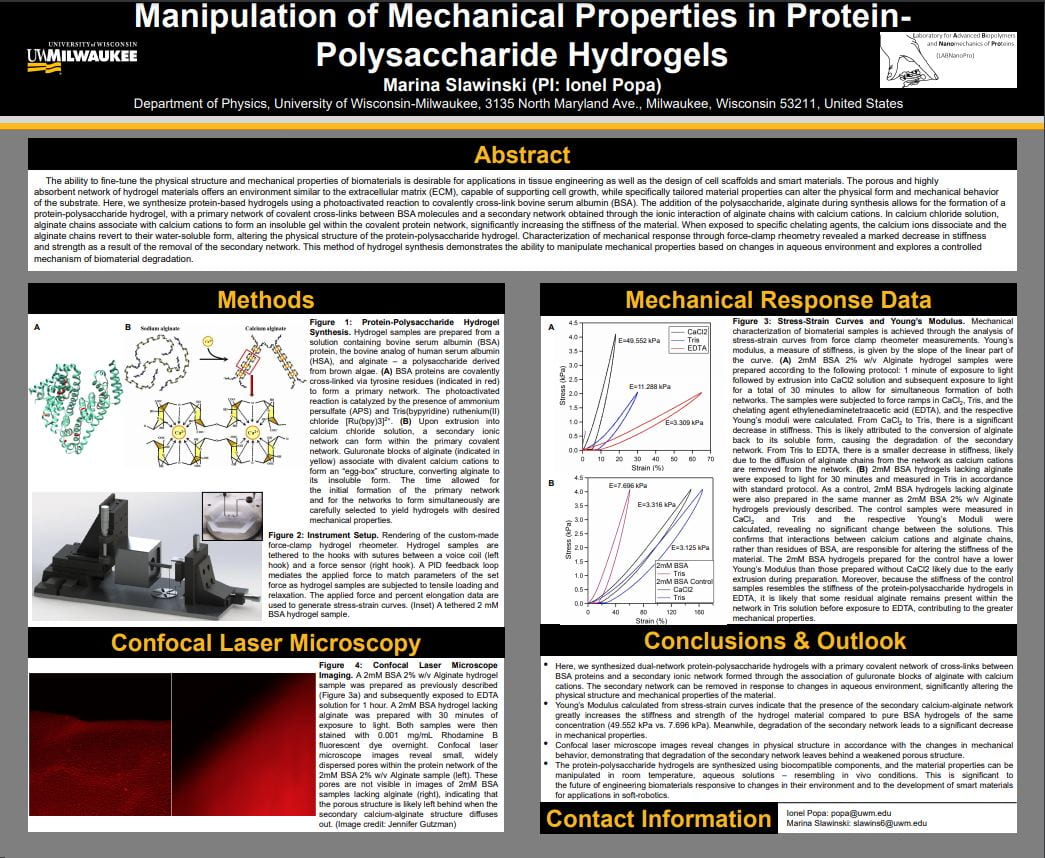Marina Slawinski, “Manipulation of Mechanical Properties in Protein-Polysaccharide Hydrogels”
Mentor: Ionel Popa, Physics
The ability to fine-tune the physical structure and mechanical properties of biomaterials is desirable for applications in tissue engineering as well as the design of cell scaffolds and smart materials. The porous and highly absorbent network of hydrogel materials offers an environment similar to the extracellular matrix (ECM), capable of supporting cell growth, while specifically tailored material properties can alter the physical form and mechanical behavior of the substrate. Here, we synthesize protein-based hydrogels using a photoactivated reaction to covalently cross-link bovine serum albumin (BSA). The addition of the polysaccharide, alginate during synthesis allows for the formation of a protein-polysaccharide hydrogel, with a primary network of covalent cross-links between BSA molecules and a secondary network obtained through the ionic interaction of alginate chains with calcium cations. In calcium chloride solution, alginate chains associate with calcium cations to form an insoluble gel within the covalent protein network, significantly increasing the stiffness of the material. When exposed to specific chelating agents, the calcium ions dissociate and the alginate chains revert to their water-soluble form, altering the physical structure of the protein-polysaccharide hydrogel. Characterization of mechanical response through force-clamp rheometry revealed a marked decrease in stiffness and strength as a result of the removal of the secondary network. This method of hydrogel synthesis demonstrates the ability to manipulate mechanical properties based on changes in aqueous environment and explores a controlled mechanism of biomaterial degradation.
Click the thumbnail below to open the full sized poster in a new tab.

Thank you for sharing your presentation on protein-polysaccharide hydrogel manipulation. It was interesting to learn about the processes that you were able to use alter the consistency of the hydrogel and to think about how these findings can be applied to biomaterials engineering.
Great work Marina. Also many thanks to Prof. Jen Gutzman on her contribution with the confocal images.
Hello! My name is Marina Slawinski and I am a junior majoring in Biomedical Engineering. I have been involved in Dr. Popa’s lab for almost three years, during which I have studied different methods of altering the mechanical and physical properties of hydrogels in response to environmental stimuli. This project focuses on the removal of a polysaccharide network from a covalent protein network to significantly change the nanostructure and mechanical properties of the hydrogel. The ability to manipulate these characteristics through external factors, such as aqueous environment, is important to the development of responsive biomaterials with applications in medicine and soft-robotics. As I consider future careers in tissue engineering and the development of biomaterials, I am excited to be a part of this project!
Thank you for taking the time to look at my poster, and please let me know if you have any questions!